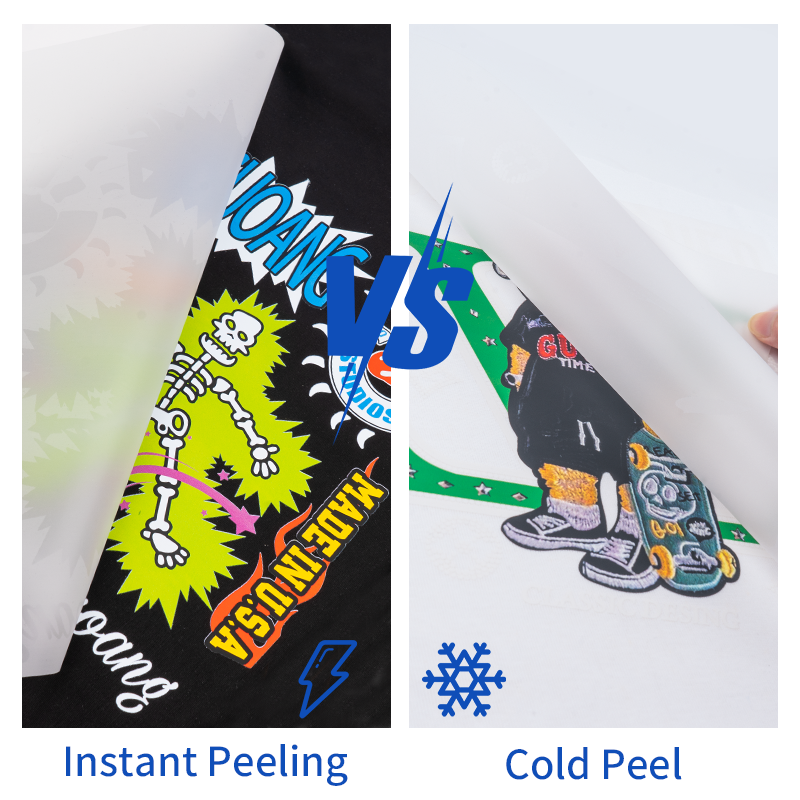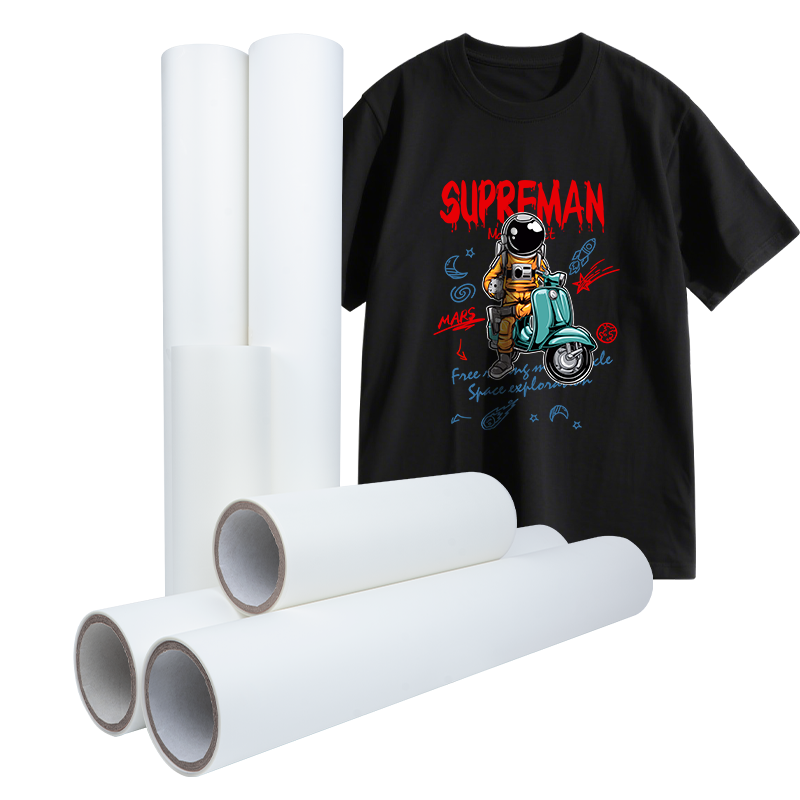Почему Мгновенное Отделение DTF-пленка Революционирует Производство Одежды
Ограничения Традиционных Методов Переноса
Традиционные методы переноса изображений сталкиваются с различными проблемами, потому что включают множество этапов — сначала печать, затем охлаждение, а потом и непосредственное нанесение. Хорошим примером здесь является шелкография, требующая слишком много ручной работы и серьёзно замедляющая производственные процессы на фабричном участке. Это создаёт трудности, когда компании стремятся нарастить объёмы производства или быстро переключаться между различными дизайнами. Подтверждением тому служат и цифры — традиционные методы в целом примерно на 30% медленнее по сравнению с более новыми альтернативами. Такая задержка вызывает проблемы с управлением уровнем запасов и реакцией на изменения на рынке. Именно поэтому многие производители в последнее время обращаются к технологии DTF-плёнки как к способу оптимизации производственных линий по выпуску одежды и выводу продукции на рынок быстрее.
Как Мгновенное Отделение Устраняет Задержки Охлаждения
Технология мгновенного отделения материала кардинально меняет процессы проектирования, поскольку позволяет производителям сразу же наносить графику, не дожидаясь охлаждения материалов. Устранение времени ожидания значительно повышает эффективность рабочих процессов и оптимизирует использование персонала на производственных линиях. Команды могут сосредоточить больше внимания на качестве продукции, при этом соответствовать требованиям более высокой скорости выполнения заказов. Согласно исследованиям в отрасли, предприятия, внедрившие этот подход, обычно сокращают общее время производства вдвое. Для производителей одежды, работающих в условиях жестких сроков и больших объемов заказов, такая экономия времени становится решающим фактором между выполнением клиентских ожиданий и срывом графика.
Сравнение скорости: мгновенная против холодной очистки
Если сравнить, как работают системы мгновенного отделения пленки, и холодные методы отделения, то не остается сомнений, какой из методов выигрывает по скорости, особенно для предприятий, занимающихся обработкой большого объема продукции. Исследования предыдущих лет демонстрируют реальное улучшение по времени выполнения задач. Бренды, перешедшие на использование пленки DTF с мгновенным отделением, сообщают о сокращении времени обработки на 70% по сравнению с холодными методами. Более быстрая обработка позволяет мастерским выполнять большие объемы заказов значительно быстрее. Клиенты остаются довольны, так как их заказы выполняются вовремя, а бизнес больше не испытывает трудностей, стараясь успеть за растущим спросом на персонализированную одежду.
Пакетная обработка для быстрых циклов модной индустрии
Современная модная индустрия развивается с невероятной скоростью, и технология мгновенной печати DTF (Direct to Film) действительно изменила подход к серийному производству. Розничные продавцы теперь могут выполнять индивидуальные заказы намного быстрее, чем раньше, что особенно важно в условиях стремительной смены трендов в сфере быстрой моды. Основное преимущество заключается в том, что более быстрое появление товаров на прилавках позволяет сократить ожидание покупателями новых моделей. По данным, которые мы наблюдали, компании, переходящие на такой способ серийной обработки, обычно увеличивают свой ежедневный выпуск продукции примерно на 40% по сравнению со старыми методами. Каков практический результат? Улучшение управления запасами в целом и возможность более быстрой реакции на появление новых стилей, набирающих популярность в интернете или на платформах социальных сетей.
Снижение затрат на труд благодаря упрощенным рабочим процессам
Пленка DTF делает производство более быстрым, а процессы — намного проще, что приводит к значительной экономии затрат на рабочую силу. Большинство людей считает процесс довольно простым, поэтому при найме новых сотрудников не требуется проходить длительное специальное обучение. Компании, перешедшие на эту технологию, сообщают об экономии около 20% на расходах, связанных с рабочей силой, просто благодаря более чистым и упрощенным процессам. Когда предприятиям больше не нужны работники со сверхспециализированными навыками, они могут направлять сэкономленные средства на такие вещи, как проверка качества и разработка новых продуктов, вместо того, чтобы тратить много времени и денег на сложные ручные процессы. Вся операция работает более гладко и позволяет достичь большего с меньшими трудностями на пути.
Выполнение срочных заказов на рекламном рынке
Мгновенные пленки DTF предоставляют компаниям реальную гибкость при работе с срочными заказами, которые постоянно возникают в рекламной деятельности. Поскольку эти пленки сокращают время производства, компании не остаются ждать вечно, когда клиентам нужно что-то экстренно подготовить к предстоящему мероприятию. Некоторые цифры также подтверждают это — бренды сообщают, что выполняют срочные заказы в три раза быстрее с использованием технологии DTF по сравнению с традиционными методами. Что это означает на практике? Маркетологи могут использовать актуальные тренды по мере их появления, вместо того, чтобы упустить возможность из-за неготовности материалов. Клиенты ценят возможность получать желаемое вовремя, что со временем укрепляет доверие и побуждает их возвращаться для участия в будущих рекламных акциях.
Современные формулы чернил для яркости цвета
Пленки DTF обладают более качественными формулами чернил, которые значительно усиливают цвета и четкость дизайнов одежды, что делает внешний вид продукции в целом намного лучше. В последнее время были достигнуты довольно интересные успехи, при которых новые чернила способны воспроизводить гораздо больше цветов, чем раньше, предоставляя дизайнерам намного больше возможностей для творчества. По результатам проведенных испытаний, одежда, изготовленная с применением технологии DTF, сохраняет свои цвета примерно на 30 процентов дольше по сравнению со старыми методами переноса. Для профессионалов в сфере моды это имеет большое значение, поскольку означает, что одежда остается яркой и привлекательной даже после многократного ношения. Разница становится заметной, когда покупатели носят одежду день за днем, не теряя свежести внешнего вида, как будто она только что с прилавка.
Прочность сцепления на разных типах тканей
Пленки DTF проявляют себя с лучшей стороны при нанесении на различные ткани — от простого хлопка до сложных полиэстеровых смесей. Такая гибкость имеет большое значение при производстве одежды, поскольку дизайнеры могут свободно экспериментировать, не опасаясь, что печать растрескается или будет выглядеть неаккуратно. Неоднократно подтверждалось, что такие пленки устойчивы к воздействию стиральных машин. Большинство клиентов отмечают, что их рисунки остаются яркими и целыми даже после десятков циклов стирки, поэтому им не нужно так часто заменять вещи.
Прочность на стирку и долгосрочное сопротивление износу
Пленки DTF отличаются прочностью, они обладают устойчивостью к стирке, превосходящей большинство стандартных методов печати, доступных на рынке сегодня. Футболки, напечатанные с использованием этой технологии, сохраняют хороший внешний вид даже после нескольких месяцев регулярного ношения, что объясняет, почему так много текстильных компаний предпочитают использовать этот метод, когда требуется продукция, служащая дольше, чем средняя одежда. Некоторые лабораторные испытания показали, что изделия, напечатанные с помощью DTF, могут выдержать около 50 обычных домашних стирок перед тем, как появятся реальные признаки потери цвета или отслоения от ткани. Для производителей, обеспокоенных качеством продукции и удовлетворенностью клиентов, печать DTF становится все более популярной, поскольку она обеспечивает стабильные результаты на разных типах и цветах тканей без легкого разрушения.
Смеси хлопка/полиэстера до функциональных тканей
Пленки DTF демонстрируют отличные результаты на различных тканях — от хлопковых смесей до технических тканей, что делает их идеальным выбором для множества различных применений. Их способность адаптироваться открывает большие возможности для технологии DTF на таких рынках, как одежда для активного отдыха и деловая одежда. Даже эластичные материалы не представляют никакой проблемы для этих пленок, поэтому напечатанные изображения остаются яркими и красочными, при этом ткань сохраняет свои свойства. По мере того, как потребители продолжают искать варианты печати, способные выдержать любые испытания, пленки DTF идеально вписываются в эту тенденцию, предлагая универсальное решение, подходящее для различных типов тканей и фасонов одежды.
Декорирование одежды vs Применения на жестких поверхностях
Печать непосредственно на пленке выходит за рамки обычных тканей и позволяет компаниям создавать яркие, красочные изображения на прочных материалах, таких как пластиковые пакеты, чехлы для телефонов и различные рекламные изделия. То, что этот метод работает на нематериальных поверхностях, открывает совершенно новые рынки для бизнеса, стремящегося расширить ассортимент за счет персонализированных продуктов. Некоторые компании, внедрившие DTF-технологию для обработки таких сложных поверхностей, сообщили о приросте продаж на уровне 25%, запустив эти новые линейки продукции. Ценность этой технологии заключается в том, что она дает производителям дополнительную возможность расширять ассортимент без значительных затрат, по сути, создавая новые каналы дополнительного дохода там, где их раньше не было.

Сезонная адаптация для производства круглый год
Пленки DTF позволяют компаниям согласовывать свои производственные графики с тем, что сейчас популярно на рынке, упрощая корректировку дизайнов при необходимости. Бренды могут без особых усилий переходить от одной коллекции к другой, что позволяет поддерживать актуальный вид ассортимента и соответствовать тому, что покупатели действительно хотят носить или приобрести в наше время. Когда компании быстро реагируют на запросы потребителей сезон за сезоном, они, как правило, наблюдают лучшие результаты в продажах. Некоторые предприятия зафиксировали рост показателей продаж на 15 пунктов с момента внедрения технологии DTF. Это демонстрирует важность актуальности в течение всего года и удовлетворения ожиданий покупателей, которые стремятся к моде, соответствующей текущему моменту.
Рост услуг по индивидуальной кастомизации по запросу
Технология прямой печати на ткани (DTF) меняет принцип работы по производству персонализированных товаров, поскольку позволяет компаниям выпускать яркие и качественные принты намного быстрее, чем традиционные методы. Исследования рынка также показывают интересную тенденцию — примерно 7 из 10 человек сегодня хотят носить одежду, созданную специально для них, что свидетельствует о переходе к более индивидуальному подходу. Из-за этой тенденции многие компании начинают инвестировать в системы DTF-плёнок. Такие комплексы позволяют производителям оперативно реагировать на пожелания клиентов и легко интегрироваться в существующие производственные линии без значительных изменений. Финансовые выгоды также впечатляют: компании, перешедшие на DTF, сообщают о значительном росте прибыли, при этом некоторые оценивают увеличение доходов от дополнительных возможностей персонализации примерно на 20%.
Преимущества устойчивого развития перед трафаретной печатью
По сравнению с традиционной шелкографией, которая оставляет много отходов материалов и требует значительного количества химических веществ, мгновенные пленки DTF представляют собой более экологичную альтернативу для печати. Эти новые технологии значительно сокращают отходы чернил, используя при этом гораздо меньше агрессивных веществ в процессе производства. По данным отраслевых отчетов, при переходе компаний с традиционной трафаретной печати на решения с использованием DTF-пленок объем выбросов углерода снижается примерно на 40 процентов. Помимо соблюдения экологических норм, этот переход к устойчивому производству становится реальным преимуществом при продажах, поскольку все больше покупателей ищут продукты, изготовленные с применением ответственных производственных процессов.
Прогнозируемый среднегодовой темп роста (CAGR) 6% до 2030 года
Согласно прогнозам рынка, технология пленки DTF будет расти примерно на 6% в год в течение следующего десятилетия до 2030 года. Почему? Дело в том, что в наше время люди хотят более персонализированных товаров, особенно когда речь идет о одежде и других печатных продуктах. Мода на уникальные изделия в индустрии моды превратилась в серьезный бизнес. Для компаний, которые смотрят в будущее, технология DTF представляет собой нечто действительно важное в современном рынке одежды. Она хорошо работает, потому что легко масштабируется, экономит время при серийном производстве и быстро адаптируется к текущим потребностям клиентов. Рост на 6% — это не просто цифры на бумаге. Умные инвесторы уже отслеживают, как рынки движутся в сторону персонализированных дизайнов и более экологичных производственных процессов, что делает пленки DTF заслуживающими серьезного внимания для тех, кто хочет оставаться конкурентоспособным в этой сфере.
Раздел часто задаваемых вопросов
Что такое технология пленки DTF?
Технология DTF (Direct-to-Film) — это передовой метод печати, используемый в производстве одежды, который позволяет создавать яркие и долговечные дизайны на тканях через процесс термопереноса.
Как технология мгновенного отслаивания повышает производственную эффективность?
Технология мгновенного снятия устраняет фазу охлаждения, необходимую в традиционных методах переноса, значительно ускоряя производственный процесс за счет немедленного нанесения дизайна.
С какими типами тканей совместимы пленки DTF?
Пленки DTF универсальны и эффективно прилипают к широкому спектру типов тканей, включая хлопок, смеси полиэстера и технические текстильные материалы, не снижая качества дизайна.
Является ли технология DTF более экологичной, чем традиционные методы?
Да, технология DTF более экологична, так как она снижает отходы материалов и использование химикатов по сравнению с традиционными методами шелкографии, обеспечивая меньший углеродный след.
Могут ли пленки DTF использоваться на материалах, отличных от ткани?
Да, технология DTF применима к твердым поверхностям, таким как сумки и рекламные изделия, что позволяет расширить рынок на сторону индивидуальных сувениров помимо одежды.
Содержание
-
Почему Мгновенное Отделение DTF-пленка Революционирует Производство Одежды
- Ограничения Традиционных Методов Переноса
- Как Мгновенное Отделение Устраняет Задержки Охлаждения
- Сравнение скорости: мгновенная против холодной очистки
- Пакетная обработка для быстрых циклов модной индустрии
- Снижение затрат на труд благодаря упрощенным рабочим процессам
- Выполнение срочных заказов на рекламном рынке
- Современные формулы чернил для яркости цвета
- Прочность сцепления на разных типах тканей
- Прочность на стирку и долгосрочное сопротивление износу
- Смеси хлопка/полиэстера до функциональных тканей
- Декорирование одежды vs Применения на жестких поверхностях
- Сезонная адаптация для производства круглый год
- Рост услуг по индивидуальной кастомизации по запросу
- Преимущества устойчивого развития перед трафаретной печатью
- Прогнозируемый среднегодовой темп роста (CAGR) 6% до 2030 года
- Раздел часто задаваемых вопросов



